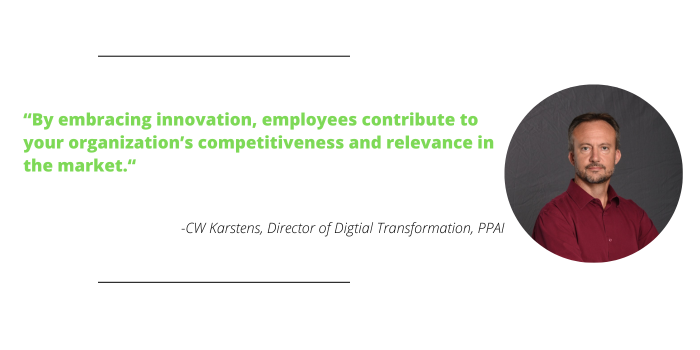CW Karstens: Cultivating Employees' Innovation Mindset

In the dynamic landscape of today’s business world, innovation stands as the cornerstone of success and sustainability. As organizations strive to stay ahead of the curve, the need for constant adaptation and creativity becomes increasingly paramount.
However, convincing employees to embrace innovation can be a challenging task. It requires a cultural shift and a willingness to embrace change.
In this column, I will explore the importance of innovation in the workplace and outline strategies to cultivate a mindset that fosters creativity and adaptability among employees.
Elevate Innovation
First and foremost, it is crucial to underscore the direct link between innovation and organizational success. In an era where technological advancements and market dynamics evolve rapidly, businesses that fail to innovate risk falling behind. By embracing innovation, employees contribute to your organization’s competitiveness and relevance in the market.
The ability to adapt and innovate is not just a desirable trait; it is a survival imperative. Employees need to understand that innovation is not merely a buzzword but a fundamental aspect of securing the future of the organization and, consequently, their own professional growth.

Innovation = Company Culture
To encourage innovation, organizations must establish a culture that promotes experimentation and learning from failure.
Employees often resist change due to fear of the unknown or concern about potential negative consequences. By fostering a culture that celebrates risk-taking and learning from mistakes, organizations can create an environment where employees feel supported in their innovative endeavors. This can be achieved through initiatives such as innovation workshops, hackathons or designated time for employees to work on personal projects that align with the company’s goals.
Countless times, I have joined a team or organization and quickly realized that a culture of keeping your head down and just doing what you were told was prevalent. It’s important that when a mistake is made, leaders ask how we can solve it and then prevent it, not ask who made the mistake and punish them or call them out. Subtle ways in how you respond can make impactful behavioral changes in an organization, for better or worse.
Share The News
Effective communication is pivotal in garnering employee buy-in for innovation. Leaders must articulate a compelling vision that illustrates how innovation aligns with the organization’s values and long-term objectives. When employees understand the purpose behind innovation efforts, they are more likely to feel a sense of purpose and connection to the larger mission.
Regular communication that is both transparent and inclusive builds trust and keeps employees informed about the progress and impact of innovation initiatives. This ensures that employees feel valued and recognize their contribution to the organization’s success.
When implementing a new process or tool, showing the benefits and getting buy-in goes a long way in faster and more successful adoption. Forcing a change causes resentment and frustration.
Develop The Right Skills
Organizations should invest in training programs that equip employees with the skills necessary for innovative thinking. Innovation is not limited to a select few; it is a collective effort that thrives when individuals from various backgrounds and skill sets collaborate.
Training programs can include workshops on creative problem-solving, design thinking and other methodologies that stimulate innovation. These programs empower employees to approach challenges with a fresh perspective, sparking creative solutions that may not have been apparent before.
For implementing innovative changes, ensuring that training is engaging and fits within busy schedules helps. Being able to confirm that training was completed, and skills were developed also improves success. Too often, training and documentation is poorly implemented, and people then struggle to fully grasp the new tool or process, making their stress higher rather than lower.
Celebrate Progress
Recognizing and rewarding innovative efforts is another powerful strategy to encourage employees to embrace innovation. When employees see that their contributions are valued and acknowledged, they are motivated to continue seeking innovative solutions.
Recognition can take various forms, such as monetary rewards, public acknowledgment or opportunities for career advancement. By creating a culture of appreciation for innovation, organizations reinforce the idea that creativity is not just welcomed but essential to individual and collective success.
Convincing employees to embrace innovation requires a multifaceted approach that addresses the cultural, communication and skill development aspects of the workplace.
Through the steps outlined here, your organization can create an environment where employees not only accept change but actively contribute to the innovative endeavors that propel the organization forward. In doing so, businesses can position themselves as leaders in their respective industries and cultivate a workforce that thrives on the challenges and opportunities presented by an ever-evolving business landscape.
Karstens is PPAI’s director of digital transformation.

